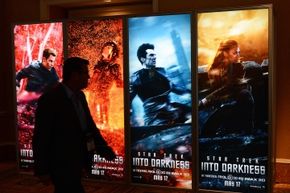Color Theory at the Movies
Every movie poster starts with a color scheme, and modern poster designers choose colors designed to catch your eye. Unfortunately, too many of these designers choose the exact same colors, resulting in posters that look suspiciously alike.
Need proof? Next time you head to the movies, count how many posters rely on a combination of orange and blue to sell you on a movie. Once you start looking, you'll find this pair of colors everywhere, from "The Incredible Hulk," to "Night at the Museum" to "The Bourne Identity." [source: Barackman].
Advertisement
But why do so many posters feature this same orange and blue pairing? It all goes back to color theory and the good ol' reliable tool of designers, the color wheel. On a color wheel, colors that sit directly opposite one another are natural complements. Placing complementary hues like orange and blue in close proximity provides the perfect level of contrast to draw your attention to a particular film [source: Duarte].
The popularity of orange and blue lies in the fact that many other color combinations are already associated with something in our minds. Red and green clearly evoke thoughts of Christmas -- which won't work for most films -- while shades of blue and pink are too closely aligned with babies to work well with most movie posters [source: Barackman]. When it comes to the romantic comedy, white backgrounds rule thanks to the light, good-natured feelings they evoke.
Designers looking to be different might want to check out violet and yellow, which also sit opposite one another on the wheel yet aren't commonly found on movie posters. Designers could also turn to another combination -- the black, white and orange trifecta used on a large number of action films [source: Barackman]. Orange means plenty of explosions, right?
Before you find yourself being too hard on poster makers, consider that it could very well be your own preferences for certain genres that are driving movie poster color selections. In 2012, engineer Vijay Pandurangan proved definitively that movie posters have grown both darker and bluer over the past century. Why the decrease in brighter hues? It could be due to a demand for thrillers and action flicks, which tend to require darker, more "masculine" shades [source: Miramax].
Obviously, it's not just color that's causing movie posters to look alike. Read on to discover how a handful of similar images and poses dominate box office artwork.
